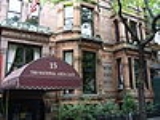
Samuel J. Tilden House
Encyclopedia
The Samuel J. Tilden House was the home of Samuel J. Tilden
, former governor of the U.S. state
of New York
and fierce opponent of the Tweed Ring and Tammany Hall
. Originally built in 1845, Tilden lived in the brownstone from 1860 until his death in 1885. In 1874, Calvert Vaux
combined it with another house, also built in 1845, to make the building that now stands.
 Tilden ran for president
Tilden ran for president
in 1876
, winning the popular vote, but losing the electoral college
to Rutherford B. Hayes
. This was one of the end points of the Reconstruction. In those tumultuous times, he had both rolling steel doors and a secret escape tunnel.
Since 1906, the house has been occupied by the National Arts Club
, a private arts club.
The building was declared a National Historic Landmark
in 1976. It is located in the Gramercy Park Historic District.
Samuel J. Tilden
Samuel Jones Tilden was the Democratic candidate for the U.S. presidency in the disputed election of 1876, one of the most controversial American elections of the 19th century. He was the 25th Governor of New York...
, former governor of the U.S. state
U.S. state
A U.S. state is any one of the 50 federated states of the United States of America that share sovereignty with the federal government. Because of this shared sovereignty, an American is a citizen both of the federal entity and of his or her state of domicile. Four states use the official title of...
of New York
New York
New York is a state in the Northeastern region of the United States. It is the nation's third most populous state. New York is bordered by New Jersey and Pennsylvania to the south, and by Connecticut, Massachusetts and Vermont to the east...
and fierce opponent of the Tweed Ring and Tammany Hall
Tammany Hall
Tammany Hall, also known as the Society of St. Tammany, the Sons of St. Tammany, or the Columbian Order, was a New York political organization founded in 1786 and incorporated on May 12, 1789 as the Tammany Society...
. Originally built in 1845, Tilden lived in the brownstone from 1860 until his death in 1885. In 1874, Calvert Vaux
Calvert Vaux
Calvert Vaux , was an architect and landscape designer. He is best remembered as the co-designer , of New York's Central Park....
combined it with another house, also built in 1845, to make the building that now stands.

President of the United States
The President of the United States of America is the head of state and head of government of the United States. The president leads the executive branch of the federal government and is the commander-in-chief of the United States Armed Forces....
in 1876
United States presidential election, 1876
The United States presidential election of 1876 was one of the most disputed and controversial presidential elections in American history. Samuel J. Tilden of New York outpolled Ohio's Rutherford B. Hayes in the popular vote, and had 184 electoral votes to Hayes's 165, with 20 votes uncounted...
, winning the popular vote, but losing the electoral college
Electoral college
An electoral college is a set of electors who are selected to elect a candidate to a particular office. Often these represent different organizations or entities, with each organization or entity represented by a particular number of electors or with votes weighted in a particular way...
to Rutherford B. Hayes
Rutherford B. Hayes
Rutherford Birchard Hayes was the 19th President of the United States . As president, he oversaw the end of Reconstruction and the United States' entry into the Second Industrial Revolution...
. This was one of the end points of the Reconstruction. In those tumultuous times, he had both rolling steel doors and a secret escape tunnel.
Since 1906, the house has been occupied by the National Arts Club
National Arts Club
The National Arts Club is a private club in Gramercy Park, New York City, New York, USA. It was founded in 1898 to "stimulate, foster, and promote public interest in the arts and to educate the American people in the fine arts". Since 1906 the organization has occupied the Samuel J...
, a private arts club.
The building was declared a National Historic Landmark
National Historic Landmark
A National Historic Landmark is a building, site, structure, object, or district, that is officially recognized by the United States government for its historical significance...
in 1976. It is located in the Gramercy Park Historic District.
See also
- National Register of Historic Places listings in Manhattan from 14th to 59th StreetsNational Register of Historic Places listings in Manhattan from 14th to 59th StreetsThis is a list of properties and districts in Manhattan from 14th to 59th Streets that are listed on the National Register of Historic Places.This is intended to be a complete list of properties and districts listed on the National Register of Historic Places in Manhattan from 14th to 59th Streets...

